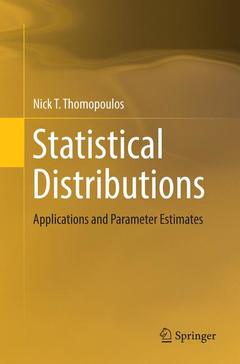Description
Statistical Distributions, Softcover reprint of the original 1st ed. 2017
Applications and Parameter Estimates
Author: Thomopoulos Nick T.
Language: English
Subject for Statistical Distributions:
147.69 €
In Print (Delivery period: 15 days).
Add to cartPublication date: 08-2018
Support: Print on demand
147.69 €
In Print (Delivery period: 15 days).
Add to cartPublication date: 10-2017
Support: Print on demand
Description
/li>Contents
/li>Biography
/li>Comment
/li>
Accuracy in choosing and applying statistical distributions is particularly imperative for anyone who does statistical and probability analysis, including management scientists, market researchers, engineers, mathematicians, physicists, chemists, economists, social science researchers, and students in many disciplines.
1.1 Introduction
Probability Distributions, Random Variables, Notation and Parameters
1.2 Fundamentals
1.3 Continuous Distribution
Admissible Range
Probability Density
Cumulative DistributionComplementary Probability
Expected Value
Variance and Standard Deviation
Median
Coefficient-of-Variation1.4 Discrete Distributions
Admissible Range
Probability Function
Cumulative Probability
Complementary ProbabilityExpected Value and Mean
Variance and Standard Deviation
Median
Mode
Lexis Ratio1.5 Sample Data Basic Statistics
1.6 Parameter Estimating Methods
Maximum-Likelihood-Estimator (MLE)
Method-of-Moments (MoM)
1.7 Transforming Variables
Transform Data to Zero or Larger
Transform Data to Zero and One
Continuous Distributions and Cov
Discrete Distributions and Lexis Ratio1.8 Summary
2. Continuous Uniform
Fundamentals
Sample Data
Parameter Estimates from Sample Data
Parameter Estimates when No Data
When (a, b) Not Known
Summary
3. Exponential
Fundamentals
Table Values
Memory-Less Property
Poisson Relation
Sample Data
Parameter Estimate from Sample Data
Parameter Estimate when No Data
Summary
4. Erlang
Introduction
Fundamentals
Tables
Sample Data
Parameter Estimates when Sample Data
Parameter Estimates when No Data
Summary
5. Gamma
Introduction
Fundamentals
Gamma Function
Cumulative Probability
Estimating the Cumulative Probability
Sample Data
Parameter Estimates when Sample Data
Parameter Estimate when No DataSummary
6. Beta
IntroductionFundamentals
Standard Beta
Beta has Many Shapes
Sample Data
Parameter Estimates when Sample Data
Regression Estimate of the Mean from the Mode
Parameter Estimates when No Data
Summary
7. Weibull
Introduction
Fundamentals
Standard Weibull
Sample Data
Parameter Estimate of when Sample Data
Parameter Estimate of (k1, k2) when Sample Data
Solving for k1Solving for k2
Parameter Estimate when No Data
Summary
8. Normal
Introduction
Fundamentals
Standard Normal
Hastings Approximations
Approximation of F(z) from z
Approximation of z from F(z)
Tables of the Standard Normal
Sample DataParameter Estimates when Sample Data
Parameter Estimates when No Data
Summary
9. Lognormal
Introduction
Fundamentals
Lognormal Mode
Lognormal Median
Sample Data
Parameter Estimates when Sample Data
Parameter Estimates when No Data
Summary
10. Left Truncated Normal
Introduction
Fundamentals
Standard Normal
Sample Data
Parameter Estimates when Sample DataLTN in Inventory Control
Distribution Center in Auto Industry
Dealer, Retailer or Store
Summary
11. Right Truncated Normal
Introduction
Fundamentals
Standard Normal
Right-Truncated Normal
Cumulative Probability of k
Mean and Standard Deviation of t
Spread Ratio of RTN
Table Values
Sample Data
Parameter Estimates when Sample Data
Estimate when RTN
Estimate the -percent-point of xSummary
12. Triangular
Introduction
Fundamentals
Standard Triangular
Triangular
Parameter Estimates when No Data
Summary
13. Discrete Uniform
Introduction
Fundamentals
Lexis Ratio
Sample Data
Parameter Estimates when Sample Data
Parameter Estimates when No Data
Summary
14. Binomial
IntroductionFundamentals
Lexis Ratio
Normal Approximation
Poisson Approximation
Sample Data
Parameter Estimates with Sample Data
Parameter Estimates when No Data
Summary
15. Geometric
Introduction
Fundamentals
Number of Failures
Sample Data
Parameter Estimate with Sample Data
Number of Trials
Sample Data
Parameter Estimate with Sample Data
Parameter Estimate when No Sample Data
Lexis Ratio
Memory Less Property
Summary
16. Pascal
Introduction
Fundamentals
Number of Failures
Parameter Estimate when No Data
Number of Trials
Lexis Ratio
Parameter Estimate when Sample Data
Summary
17. Poisson
Introduction
Fundamentals
Lexis Ratio
Parameter Estimate when Sample DataParameter Estimate when No Data
Exponential Connection
Summary
18. Hyper Geometric
Introduction
Fundamentals
Parameter Estimate when Sample Data
Binomial Estimate
Summary
19. Bivariate Normal
Introduction
Fundamentals
Bivariate Normal
Marginal Distributions
Conditional Distribution
Bivariate Standard Normal
Distributions
Approximation to the Cumulative Joint ProbabilityStatistical Tables
Summary
20. Bivariate Lognormal
Introduction
Fundamentals
Summary
Nick T. Thomopoulos, Ph.D., has degrees in business (B.S.) and in mathematics (M.A.) from the University of Illinois, and in industrial engineering (Ph.D.) from Illinois Institute of Technology (Illinois Tech). He was supervisor of operations research at International Harvester; senior scientist at Illinois Tech Research Institute; Professor in Industrial Engineering, and in the Stuart School of Business at Illinois Tech. He is the author of eleven books including Fundamentals of Queuing Systems (Springer), Essentials of Monte Carlo Simulation (Springer), Applied Forecasting Methods (Prentice Hall), and Fundamentals of Production, Inventory and the Supply Chain (Atlantic). He has published many papers and has consulted in a wide variety of industries in the United States, Europe and Asia. Dr. Thomopoulos has received honors over the years, such as the Rist Prize from the Military Operations Research Society for new developments in queuing theory; the Distinguished Professor Award in Bangkok, Thailand from the Illinois Tech Asian Alumni Association; and the Professional Achievement Award from the Illinois Tech Alumni Association.
Includes 89 examples that help the reader apply the concepts presented
Explains how to compute cumulative probability for all distributions including Erlang, gamma, beta, Weibull, normal, and lognormal
Utilizes sample data to estimate parameter values of each distribution
Estimates parameter values when no sample data
Introduces Left-Truncated Normal, Right-Truncated Normal and Spread Ratio
Includes supplementary material: sn.pub/extras




